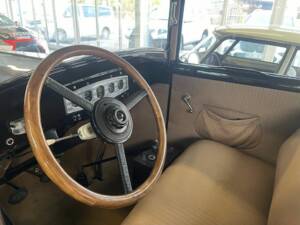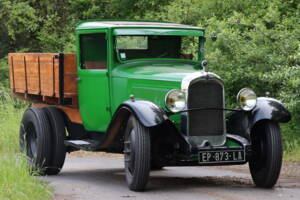Citroën C4 Classic Cars for Sale
The Citroën C4 stands as a pivotal middle-class vehicle in Citroën's lineup from 1928 to 1934, renowned for its robust engineering, broad range of body styles, and a mechanical layout cementing it as a sought-after piece among enthusiasts of early twentieth-century French automobiles.
Search results

1928 | Citroën C4
Citroën AC4 | 1928 | Route 66 Auctions - For sale by auction. Estimate 10500 EUR

1931 | Citroën C4
Reinsetzen - starten - voll funktionstüchtig - losfahren
History of the Citroën C4
The Citroën C4 was launched in 1928 at the Paris Motor Show as the successor to the Type B series, drawing inspiration from American car design yet firmly rooted in French automotive culture. Its newly designed, flat radiator grille set it apart from local rivals and reflected contemporary tastes. Produced until 1934, the C4 was available with an impressive variety of body types including luxury family cars, two- and four-seat convertibles, faux cabriolets, torpedoes, taxis, and even a chauffeur-driven Coupé de Ville in the sister C6 model. Over its lifecycle, the C4 underwent several facelifts, aligning its appearance and features with evolving automotive trends. After its production ended, it was succeeded by the Citroën Rosalie series. Notably, since 2004, the name 'C4' has been used for Citroën's compact segment models, showing the lasting influence of its predecessor.
C4 Model History
The Citroën C4 originated as the AC4, debuting in 1928, and continued through several model year revisions: the C4 III, C4F (1930), and C4G (1931). Each evolution brought technical advancements such as incremental increases in power output and improved top speeds. For example, the C4G’s enlarged engine delivered 32 bhp, marginally up from its earlier iterations. Its chassis covered wheelbases from 2790 mm to 2970 mm, accommodating various body styles and uses. Production of the C4 spanned roughly four years, after which the Citroën Rosalie replaced it. Across its existence, more than 120,000 units found their way to customers, reflecting its practical appeal.
Highlights and Market Significance
A notable feature of the Citroën C4 was its wide range of available body variants, including rare luxury and utilitarian adaptations. The introduction of a very flat radiator grille, American-inspired design cues, and robust mechanical setup defined its period. The C4 was especially praised for its ease of driving and durability, enhanced by features like full drum brakes on both axles and the option for luxury interiors.
Technical Data
Special Editions and Collectible Models
While the Citroën C4 boasted a range of configurations, certain special variants stand out, particularly convertibles (‘Décapotable’), faux cabriolets, and taxis commissioned for specific fleet purposes. Additionally, unique deluxe interior trims and rare accessories—such as early dual windscreen setups for Double Phaeton models and original period-correct exterior colour combinations (including sand-beige and two-tone options)—make specific vehicles especially noteworthy among collectors.
Engine, Transmission, and Handling
The base Citroën C4 is powered by a 1.6-litre, side-valve inline-four, delivering 30 horsepower at 3000 rpm via a 3-speed manual gearbox. The car achieves a top speed of 90 km/h and is supported by full drum brakes on both axles. Known for its unpretentious driving characteristics, the C4 delivers stable cornering for its era thanks to its long wheelbase, and the robust mechanics ensure dependable function with correct maintenance. Later derivatives, including the C4G, increased engine output and fine-tuned driveability. Modern reinterpretations from 2004 onwards offered significantly advanced specs, with the top trim producing 205 km/h and 0–100 km/h in just over 10 seconds. Standout body styles include the Berline Luxe (luxury saloon), Conduite Interieure Luxe, and the rare Faux Cabriolet. Modern C4 iterations strong in efficiency (5.1 l/100 km average, emissions class Euro 0 to B depending on year) continue to evolve the original's ethos into the compact class.
Interior, Comfort, Exterior and Design
The Citroën C4’s design was influenced by contemporary American style, yet retained French sensibility—demonstrated by its very flat radiator grille and well-proportioned bodywork. Special features included luxury wood steering wheels, genuine leather upholstery, and hand-fitted carpet, offering a comfortable, period-appropriate interior for its era. Exteriors were available in distinctive sand-beige or red-black colour schemes, and deluxe editions occasionally featured dual windshields for Phaeton bodies, additional external lighting, period-specific horns (Gurtner), and rear trunks for added luggage. Attention to accessory detail was a clear hallmark, catering to both aesthetic and functional demands.
Other Notable Features
Several models were fitted ex-factory or via dealer option with supplementary Marchal driving lights, rear-mounted luggage trunks, and elegantly designed dashboards adorned with period-correct switchgear. Certain taxis and professional variants came equipped with more robust rear suspensions and durable seating, adapating the C4 for commercial use as well.
Summary
The Citroën C4 holds a significant place among collectable French automobiles for its mechanical robustness, diversity of factory configurations, and a distinctively period-correct appearance. With a large share both in supply and search interest—over 92% among Citroën classics—this model appeals to collectors appreciative of pre-war engineering and the golden age of French automotive design.

